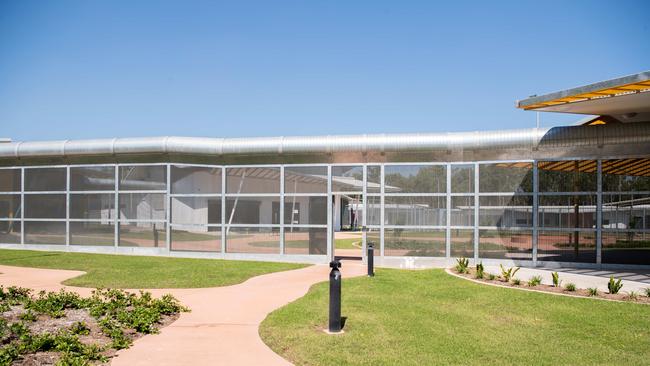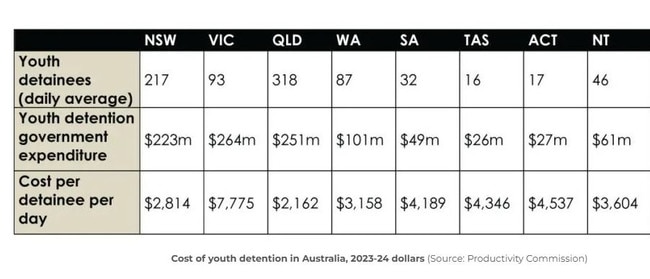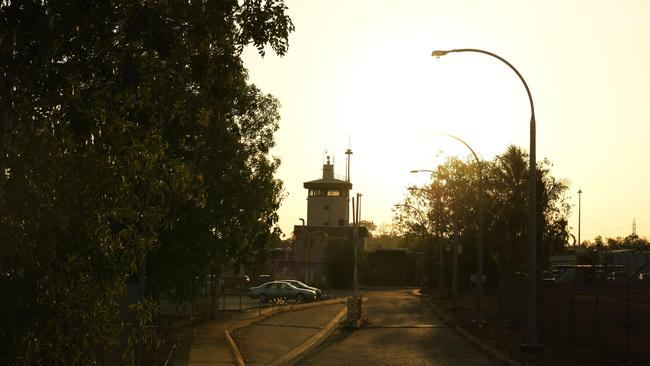Productivity Commission report reveals NT Government is spending $3600 per youth offender a day
The Northern Territory Government is spending more than $3600 a day to keep one youth offender in prison, a new report has found, with one research expert slamming the nation’s leaders as “failing” at early invention.

News
Don't miss out on the headlines from News. Followed categories will be added to My News.
The Northern Territory Government is spending more than $3600 a day to keep just one youth offender in prison, a new report has found, with one research expert slamming the nation’s leaders as “failing” at early invention.
Last week, the Productivity Commission released its Government Services 2025 report, which showed the state-by-state cost of locking up kids between 2023 and 2024.
With a daily average of 46 kids behind bars and government expenditure of $61 million, the Territory’s cost per detainee per day was $3604.
The figure dwarfed Queensland and NSW which registered $2162 and $2814 respectively.
Victoria registered the highest average cost at $7775 per detainee, due to a daily average of 93 detainees backed by $264 million in government funding.
Collectively, Australian jurisdictions spent more than $1 billion on youth detention – almost $100 million more than 2022-23.
The report’s findings drew the ire of IPA research fellow Mia Schlicht, who lamented the latest figures.
“Although the number of youth offenders in detention has remained largely unchanged, Australia continues to spend more on youth detention,” she said.
“Worryingly, violent youth offending is being left unchecked and is rising.”

Ms Schlicht said violent crime was “not being addressed” despite more cash being thrown at youth detention.
“Over the past decade, the number of youth offenders prosecuted for violent crimes has increased by 28 per cent (nationwide),” she said.
“Despite this, the number of youth offenders in detention has not changed. The numbers do not add up.”
Ms Schlicht lashed political leaders for the mounting figures.
“Governments are failing on two fronts – first, they are not effectively intercepting anti-social youth behaviour,” she said.
“And second, once offenders become violent, they are not being removed from the environment that is fostering this behaviour.”

Ms Schlicht maintained alternative punishments, such as rehabilitation centres, would serve as a circuit breaker for ‘nonviolent’ recidivism, as well as alleviate the financial burden on the taxpayer.
“Non-violent youth offenders should be diverted from detention, which in many cases lead to escalating recidivism, and instead be given the skills to gain employment and financial independence at rehabilitation facilities,” she said.
“Not only will this set them up for a better future, but will save money for taxpayers in the long run.”
The report comes as the Finocchiaro Government doubled down on its promise to tackle crime last month, with Corrections Minister Gerard Maley revealing authorities had been advised to “arrest as many” offenders necessary to keep the peace.
“What we say is if the community is in risk or in danger, we want you to keep the community safe,” he told a press conference.
“That includes arresting people – arrest as many as you need to keep the community safe.”

A Corrections spokesman told this masthead the Productivity Commission’s figures were correct.
“Over the past five years, the number of young people aged 10 – 17 rose from 36 in 2018-19 to 54 in 2022-23,” he said.
“As such, the NT reported an increase in the real recurrent expenditure per young person in detention compared to the previous years.”
The spokesman said there were additional costs to managing youth offenders.
“The NT also invests close to $3 million per year in treatment programs and a Specialist Assessment and Treatment Services workforce to address offending behaviour of youth while in detention, either remanded or sentenced,” he said.
“This also includes investment in programs to provide youth with the skills to gain employment and independence when released from youth detention centres.”





